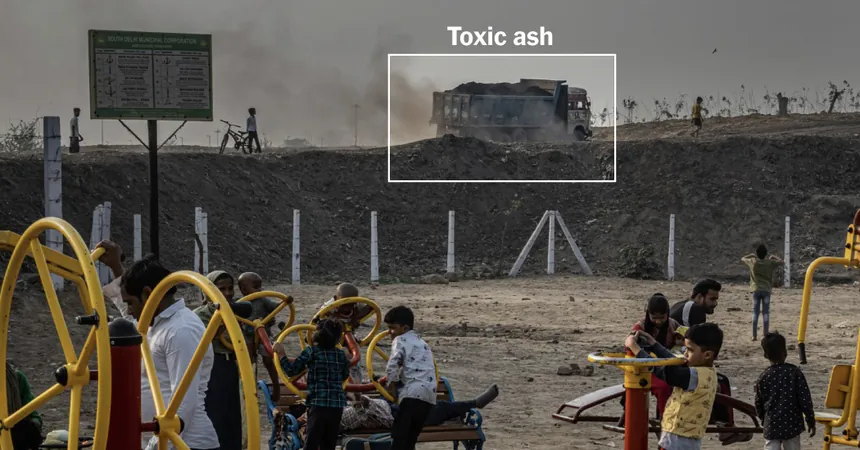
Has Delhi's ‘Green’ Revolution Turned into a Toxic Nightmare?
2024-11-09
Author: Ling
The Dilemma of Delhi's Green Revolution
As the sun rises over Delhi, a city grappling with its identity as a cultural and technological leader, a darker side lurks beneath the surface: a "Green Revolution" that promises sustainable waste management but teeters dangerously close to environmental disaster.
The Waste Crisis Unveiled
In a city renowned for its vibrant history, Delhi's government once vowed to tackle the monumental issue of trash—mountains of solid waste towering over 200 feet, endangering public health and safety. However, a comprehensive investigation unearthed alarming levels of toxic substances threatening to poison the lives of residents.
Incineration’s Dark Reality
For years, massive trucks have been shuttling through the streets of Delhi, unloading heaps of ash from incinerated refuse near homes, schools, and playgrounds. The consequences are grim: residents experience burning eyes, persistent migraines, and respiratory issues, with children crying out for help amid the choking smoke.
False Promises of Technology
While the incineration plant was marketed as a cutting-edge solution to Delhi’s trash crisis, it has instead brought suffering to its surroundings. Internal reports indicate that the facility emitted excessive quantities of dioxins—substances linked to serious health risks, including cancer. Activists and experts vehemently call this situation a form of mass poisoning, warning that approximately one million individuals are exposed to these harmful chemicals.
Government's Stubborn Commitment
The government’s response? A stubborn commitment to its "Green Growth" strategy, pursuing more waste-to-energy plants across densely populated regions. The Timarpur-Okhla Waste to Energy Plant, which incinerates around 3,000 tons of waste daily, has become a chilling blueprint for similar initiatives throughout India. Yet, many fear this approach masks the true cost of environmental degradation and public health crises.
Questions of Integrity and Safety
Even as the plant was certified by the United Nations in 2011, demonstrating its potential for generating carbon credits, interviews with former employees reveal that fundamental safety regulations were often ignored to cut operational costs. Critical emission-reducing materials were rarely used, raising questions about the plant's integrity and the true meaning of sustainability.
Health Crisis Intensifies
As health issues escalate among families in the vicinity, doctors like Shailendra Bhadoriya lament the toll on their lives. Residents report rising cases of asthma, severe bronchitis, and other ailments common in areas plagued by air pollution. Neeta Mishra, an obstetrician, has noticed an alarming surge in birth defects and miscarriages since the facility became operational, urging expectant mothers to seek refuge elsewhere.
Regulatory Failures
The environmental oversight of such facilities has proven inadequate. With only a handful of scientists regulating pollution across a sprawling metropolis, the Delhi Pollution Control Committee struggles to enforce compliance, leading to continuous violations and negligence regarding toxic emissions.
Critique of Waste-to-Energy Policies
While the Indian government champions waste-to-energy policies as solutions, critics argue it obscures the reality of a health crisis that disproportionately affects the marginalized. Many residents express helplessness, facing a dilemma of either remaining in their homes—filled with ash and toxic waste—or abandoning everything they’ve built.
Crisis Escalates
The situation intensifies as the government greenlights expanded operations at the incinerator, prioritizing energy generation over public health. Alarmingly, reports of hazardous materials—far exceeding safety thresholds—can be found contaminating air and soil.
Residents Seek Justice
Desperate residents have turned to the Supreme Court to halt operations, yet bureaucratic delays stymie their fight. Local advocates express frustration with the international community's disconnect, as well, noting that UN regulations seem ineffective in the face of grounded local neglect.
A Call for Change
The growing unrest among residents reflects a universal truth: the struggle for clean air and sustainable methods cannot be solved by profit-driven models masquerading as green initiatives. The Okhla plant reveals a sobering reality about the cost of progress—while India pursues its ambitions, it must not sacrifice the health of its citizens and the environment.
Looking Ahead
As the fight against this toxic legacy continues, the question remains: will Delhi become a symbol of innovation or a cautionary tale of environmental negligence? The answer lies in the hands of its leaders and the resilience of its people fighting for their right to a cleaner, healthier future.



 Brasil (PT)
Brasil (PT)
 Canada (EN)
Canada (EN)
 Chile (ES)
Chile (ES)
 España (ES)
España (ES)
 France (FR)
France (FR)
 Hong Kong (EN)
Hong Kong (EN)
 Italia (IT)
Italia (IT)
 日本 (JA)
日本 (JA)
 Magyarország (HU)
Magyarország (HU)
 Norge (NO)
Norge (NO)
 Polska (PL)
Polska (PL)
 Schweiz (DE)
Schweiz (DE)
 Singapore (EN)
Singapore (EN)
 Sverige (SV)
Sverige (SV)
 Suomi (FI)
Suomi (FI)
 Türkiye (TR)
Türkiye (TR)